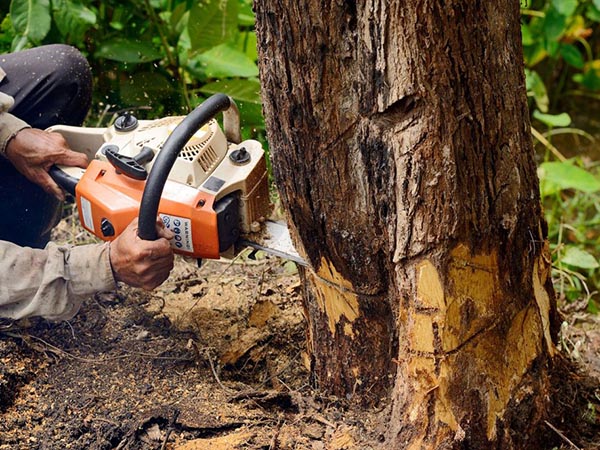Safeguarding the Process: Safety Protocols and Equipment Used to Remove a Tree
|
Apr 17, 2024 - By the dedicated team of editors and writers at Newsletter Station.

|
Trees, while beautiful and essential for our environment, sometimes need to be removed due to various reasons such as disease, damage, or encroachment on structures. However, the process of tree removal can be hazardous without proper safety protocols and equipment in place.
In this blog, we'll delve into the safety measures and equipment used to ensure a smooth and secure tree removal process.
Safety Protocols:
- Site Assessment:
Before any tree removal operation begins, a thorough site assessment is conducted. This assessment includes evaluating the tree's location, size, condition, and surrounding environment. It helps identify potential hazards and determine the safest approach for removal.
- Protective Gear:
Tree removal requires the use of specialized protective gear to ensure the safety of the arborists involved. This gear typically includes helmets, face shields, ear protection, gloves, chainsaw chaps or pants, and steel-toed boots. These items help protect against falling debris, chainsaw injuries, and other potential hazards.
- Planning and Communication:
Effective communication among the team members is crucial during tree removal operations. A detailed plan outlining the steps involved, designated roles, and emergency procedures should be developed and communicated to everyone involved. Clear communication helps minimize confusion and ensures that everyone is aware of their responsibilities.
- Establishing a Safety Zone:
Before work begins, a safety zone is established around the tree being removed. This area is restricted to authorized personnel only and is marked with cones, tape, or signs to alert others to stay clear of the work zone. Maintaining a safety zone helps prevent accidents and ensures that bystanders are kept safe during the tree removal process.
Equipment Used:
- Chainsaw:
A chainsaw is the primary tool used for cutting down trees during removal. Arborists are trained to use chainsaws safely and efficiently, following proper techniques to minimize the risk of accidents.
- Rigging Equipment:
In some cases, rigging equipment such as ropes, pulleys, and rigging slings is used to control the direction of tree fall and lower branches or sections safely to the ground. This equipment is essential for ensuring the safety of both the arborists and nearby structures.
- Aerial Lifts or Climbing Gear:
For trees that cannot be accessed safely from the ground, aerial lifts or climbing gear may be used to reach higher branches or sections. Aerial lifts provide a stable platform for arborists to work from, while climbing gear allows skilled climbers to ascend the tree safely.
- Personal Protective Equipment (PPE):
As mentioned earlier, personal protective equipment such as helmets, gloves, and chainsaw chaps are essential for the safety of the arborists. PPE helps minimize the risk of injuries from falling debris, sharp tools, and other hazards encountered during tree removal.
Tree removal is a task that requires careful planning, adherence to safety protocols, and the use of appropriate equipment. By following established safety guidelines and using the right tools for the job, arborists can ensure that the tree removal process is conducted safely and efficiently, minimizing the risk of accidents or injuries.
Prioritizing safety not only protects the workers involved but also ensures that the surrounding environment and bystanders are kept safe throughout the operation.
Unlock the Power of Email Marketing
Harness the potential of email marketing with Newsletter Station. Reach your target audience, drive conversions, and achieve your business goals.
|
More Blogs
| May 1, 2024 |
Maximizing Your Yard Space: The Benefits of Tree Removal
|
| Apr 24, 2024 |
Unearthing the Benefits: Stump Grinding After Tree Removal
|
| Apr 17, 2024 |
Safeguarding the Process: Safety Protocols and Equipment Used to Remove a Tree
|
| Apr 10, 2024 |
Tips for Landscaping Around Trees
|
| Apr 3, 2024 |
The Best Types of Mulch for Young Trees
|
| Mar 27, 2024 |
The Best Way to Remove a Tree Stump
|
| Mar 20, 2024 |
Protecting Your Trees: How to Prevent Animals from Digging Around Tree Roots
|
| Mar 13, 2024 |
Tips for Thinning Trees Growing Too Close Together
|
| Mar 6, 2024 |
The Easiest Way to Keep a Removed Tree from Regrowing
|
| Feb 28, 2024 |
How to Help Storm-Damaged Trees: A Guide to Restoration and Recovery
|
| Feb 21, 2024 |
How to Help a Tree that Is Losing Its Leaves Prematurely
|
| Feb 14, 2024 |
What to Do If Your Tree is Extending Into a Neighbor’s Property
|
|
|
|